|
Case
study 3
The murder of
political representatives of the
Croatian people committed in the
People’s Assembly on January 20,
1928 only deepened the ongoing
crisis in the Kingdom of SHS and
distrust among its constitutive
nations, the distrust historian
Milorad Ekmečić saw as worse than a
war. The situation after the
bloodshed in the parliament called
for “a statesmanlike solution.” But
who was there to find it?
“All the King was
doing at the time was trying to pour
oil on the troubled waters.”1 The
country’s leadership’s unchanged
team pursued its policy as if
nothing had happened. It demanded
convening of a “bloody”
parliamentary session (convened on
August 1, 1928) and just two weeks
after the shooting Prime Minister
Velja Vukićević resigned (July 4,
1928); premiership was assigned to
Dr. Anton Korošec, the police
minister at the time the murder had
been prepared. The newly formed
coalition government (Slovenian
People’s Party, Yugoslav Muslim
Organization, Radical Party and
Democratic Party) paid almost no
heed to strong reactions to the
parliamentary assassination at home
and abroad.2 Trumbić called this
cabinet “defiant.”
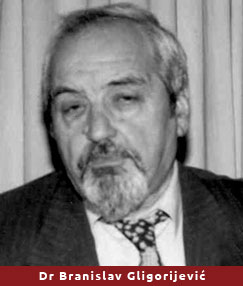 A “statesmanlike
solution” was not to be expected
from King Alexander – for two
reasons at least. He was ambitious
and self-assured about his talents.
He believed he was the second
biggest Slav ruler in the world
after Russian Tsar Nikolai II. And
above all he was an authoritarian by
nature that materialized the St.
Vitus Day Constitution. But “his
intellectual horizons and
understanding of the world were not
exactly vast or deep.”3 He was
solving crises with means that
caused them in the first place: by
force. Even if judging by some more
accurate portrait of the King
historian Branislav Gligorijević had
drawn, it must be said that his
abilities to offer a “statesmanlike
solution” were rather limited.4 The
Court had been involved in the
assassination in the Assembly. It
was only logical that the King was
lured by the solutions that had
postponed, for an entire decade, any
chance for compromise and agreement
with Croats. A “statesmanlike
solution” was not to be expected
from King Alexander – for two
reasons at least. He was ambitious
and self-assured about his talents.
He believed he was the second
biggest Slav ruler in the world
after Russian Tsar Nikolai II. And
above all he was an authoritarian by
nature that materialized the St.
Vitus Day Constitution. But “his
intellectual horizons and
understanding of the world were not
exactly vast or deep.”3 He was
solving crises with means that
caused them in the first place: by
force. Even if judging by some more
accurate portrait of the King
historian Branislav Gligorijević had
drawn, it must be said that his
abilities to offer a “statesmanlike
solution” were rather limited.4 The
Court had been involved in the
assassination in the Assembly. It
was only logical that the King was
lured by the solutions that had
postponed, for an entire decade, any
chance for compromise and agreement
with Croats.
And all that time
the country was in turmoil that
crystallized various political
demonstrations. At the news about
assassination of Croat MPs protest
broke out in several places in
Croatia. Clashes between the police
and protesters left three people
dead, 50 wounded and over one
hundred arrested.5 Everything related
to the murder triggered off
demonstrations of bitter feelings:
funerals of Dr. Đuro Basariček and
Pavle Radić; Stjepan Radić’s return
from Belgrade; and his eventual
death and funeral.
People in Serbia
were also publicly condemning the
assassination of Croat leaders as
registered in Croatian
historiography.6
Notwithstanding
the bloodshed in the parliament King
Alexander continued governing in the
manner that brought about the
assassination in the first place
(“amputation” of Croatia and
Slovenia, dictatorship, the imposed
constitution, etc.). The manner
itself did not reflect so much his
absolutist and military nature as it
did his understanding of the Kingdom
of SHS as a state. Renouncing any
idea of decentralization, autonomy
or federalism as separatism, he
actually breathed life into
separatism and made himself – and
the state as well – the target for
separatists.
Foreign diplomats
in the Kingdom were well aware of
that. So the British Ambassador
observed in his report that
Yugoslavia had been easier to
imagine than create, adding “The
pre-war Prussian arrogance had never
reached that level that could be
described by Serbian belief about
being ‘chosen people.’ Serbs are the
masters here and Serbs will be taken
accountable when a change takes
place.”7
And the French
Ambassador who had visited Slovenia
and Croatia on the eve of King
Alexander’s assassination in
Marseille, reported to his Ministry:
We can no longer close our eyes to
this unhealthy policy. I we want to
save Yugoslavia’s unity and probably
its dynasty too, we must turn to
constitutional development, based on
freedom and federalism that respects
individualities of all the peoples
in that country (emphasis – L.P.).
We should never be carried away by
the promise that we know from
experience to have carried us away
in 1930 and 1933, and go on
supporting, financially and morally,
the dictatorship.”8 However, the
bloodshed itself was a part of the
plan King Alexander had already
made: now that Stjepan Radić was
“out of the way” Croatia (along with
Slovenia) had to be too.
“Amputation:” a true intention or
just a threat?
The idea about
“amputation” of Croatia, along with
Slovenia, was a topic in Belgrade in
1920, 1923 and 1924. That was a
reaction to Croatia’s opposition to
centralism and Unitarianism. The
idea was revived after the bloodshed
in the People’s Assembly. “It was
believed that if several bullets
could disturb the entire
relationship, to shake the entire
country, it would be much better to
put an end to everything for good.
No one wants to have a civil war or
a state of emergency, but neither a
federation nor a personal union.
They should best separate peacefully
and consensually like Norway and
Sweden. They should better withdraw
from the demarcation line and inform
friendly countries about it.”9
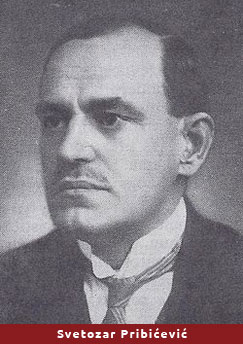 Ivan Meštrović and
Svetozar Pribićević – the latter
co-chairing Peasant Democratic
Coalition with Dr. Vlatko Maček
after Stjepan Radić had been shot
dead – left major testimonies about
the renewal of the “amputation” idea
in the summer of 1928. Accordingly,
King Alexander had told him
(Pribićević) on July 1928 to pass
his message to Stjepan Radić “who
goes to Zagreb tomorrow that he may
proclaim secession once there.” “We
can go on with Croats no more,” said
the King. And the next time they met
(July 9, 1928) he told him, “With
what will be left we will at least
have a solid state. And my late
father was saying to me that one
cannot go on with Croats, that
they’ve been enemies of Serbs for
centuries and that one cannot have a
common policy with them.”10 Pribićević
writes that he replied he was
against the “amputation” idea
warning the King of the
“international significance”
attached to the creation of a
Yugoslav state the “breakup of which
could hardly be seen as an internal
affair.”11 Ivan Meštrović and
Svetozar Pribićević – the latter
co-chairing Peasant Democratic
Coalition with Dr. Vlatko Maček
after Stjepan Radić had been shot
dead – left major testimonies about
the renewal of the “amputation” idea
in the summer of 1928. Accordingly,
King Alexander had told him
(Pribićević) on July 1928 to pass
his message to Stjepan Radić “who
goes to Zagreb tomorrow that he may
proclaim secession once there.” “We
can go on with Croats no more,” said
the King. And the next time they met
(July 9, 1928) he told him, “With
what will be left we will at least
have a solid state. And my late
father was saying to me that one
cannot go on with Croats, that
they’ve been enemies of Serbs for
centuries and that one cannot have a
common policy with them.”10 Pribićević
writes that he replied he was
against the “amputation” idea
warning the King of the
“international significance”
attached to the creation of a
Yugoslav state the “breakup of which
could hardly be seen as an internal
affair.”11
His colleague Dr.
Vlatko Maček also renounced the
possibility of “amputation.” “I am
telling you openly,” he said to the
King, “that we are not after ruining
the state, we are not after
destroying its borders.” “However,”
he continued, “we need to be fully
equal in all common affairs…In the
case of amputation, Serbians could
say that these (Croatian areas,
L.P.) but they are not. But if they
have regrets – unfortunately, we
have had, many a time – if they have
regrets, there can be a separation
but there cannot be an amputation.”12
And at his
deathbed Stjepan Radić said, “We are
intermixed so that we have to
unite…we cannot win our territories
even by a civil war unless we are
after being lost and gone forever.”13
Alongside this quote in her “20th
Century History of Yugoslavia,” the
translation of which was published
in Belgrade in 2013, Marie Janine
Čalić adds, “These words sound like
prophecy today.”14
But the
“amputation” idea was also easier to
imagine than realize. Though seeing
King Alexander as a ruler aware of
the “burden of rule” on his
shoulders, Branislav Gligorijević
says, “It was rather typical for the
King not to give another thought to
bad moments as if they had never
been, as promptly adjust himself to
new circumstances.”15
Actually, says
Gligorijević, the idea of
“amputation” was “just an
appropriate political reaction to
Croatia’s threats with secession.
Hints at separation with Croats were
meant to mobilize Serbs in Croatia
for turning to their mother
country.”16
King Alexander
dreaded the bloodshed “amputation”
could trigger off. And, at the same
time he had to take care of his
position. When he elaborated the
“amputation” idea to MP Gregor
Žerjav, the leader of Independent
Democratic Party, the latter said to
him, “Your Majesty, all this leads
toward one outcome – your
abdication. I think you are the only
king who wants to make his country
smaller.”17 King Alexander was so
angry at these words that he all but
shortened the life of his
interlocutor who a weak heart. Other
facts also indicate that
“amputation” was more of a threat
than a true intention.
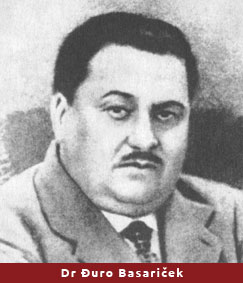 Dictatorship has
been prepared for long: most
probably ever since Nikola Pašić’s
death in 1926. With the best-known
Serbian politician out of his way
autocratic Kong Alexander thought it
would be much easier to get rid of
politician less known and of the
so-so parliamentarianism. The
parliamentary opposition saw through
his intention. Dr. Đuro Basariček,
HSS MP Puniša Račić will shoot dead
in the People’s Assembly on June 20,
1928, was alerting of “clandestine
forces” in the country. He was
referring to the secret organization
“White Hand,” the army camarilla.
King Alexander was only maneuvering
after the shooting in the People’s
Assembly. In late December 1928,
Premier Dr. Anton Korošec stepped
down. The King started consultations
with parliamentary parties.
Representatives of Peasant
Democratic Coalition were calling
for elections and a new cabinet, and
revision of the St. Vitus Day
Constitution; in other words, they
wanted to see the situation in 1918
restored. Radicals and Democrats
were against all these demands but
ready to negotiate. But the Court
interpreted all this as
parliamentary parties’ inability to
find common ground and released on
January 15, 1929 that “this is why
there are no possibilities for any
parliamentary solution that would
fully guarantee the country’s and
peoples’ unity.”18 Hence, all that is
left is a non-parliamentary
solution. Dictatorship has
been prepared for long: most
probably ever since Nikola Pašić’s
death in 1926. With the best-known
Serbian politician out of his way
autocratic Kong Alexander thought it
would be much easier to get rid of
politician less known and of the
so-so parliamentarianism. The
parliamentary opposition saw through
his intention. Dr. Đuro Basariček,
HSS MP Puniša Račić will shoot dead
in the People’s Assembly on June 20,
1928, was alerting of “clandestine
forces” in the country. He was
referring to the secret organization
“White Hand,” the army camarilla.
King Alexander was only maneuvering
after the shooting in the People’s
Assembly. In late December 1928,
Premier Dr. Anton Korošec stepped
down. The King started consultations
with parliamentary parties.
Representatives of Peasant
Democratic Coalition were calling
for elections and a new cabinet, and
revision of the St. Vitus Day
Constitution; in other words, they
wanted to see the situation in 1918
restored. Radicals and Democrats
were against all these demands but
ready to negotiate. But the Court
interpreted all this as
parliamentary parties’ inability to
find common ground and released on
January 15, 1929 that “this is why
there are no possibilities for any
parliamentary solution that would
fully guarantee the country’s and
peoples’ unity.”18 Hence, all that is
left is a non-parliamentary
solution.
Already on January
6, 1929 “Official Gazette” published
King Alexander’s Proclamation
saying, “The time has come for no
one who may or should be standing
between the People and the King.”19
The constitution was annulled and
the People’s Assembly dismissed. The
Court’s high efficiency testifies
that dictatorship has been prepared
for long.
King Alexander
entrusted Gen. Petar Živković with
the premiership for two reasons: the
army was his main pillar; and, the
General had been a time-tested
friend of the Karađorđević dynasty.
He had been an accomplice in the
murder of the last of Obrenovićs on
May 29, 1903 and a false witness
against Dragutin Dimitrijević Apis
in 1917 in Salonika. Gen. Petar
Živković proclaimed that his
cabinet’s main goal would be “to
impose order and discipline on the
administration” and “to harmonize
legislation in the entire state as
soon as possible and thus fully
ensure law and order.”20
Along with the
King’s Proclamation (January 6, 929)
the Official Gazette published the
laws that institutionalized
dictatorship. The Law on the King’s
Rule and Supreme Administration
provided that the King shall hold
all the reins in the country and
that he “shall be untouchable.” The
Law on the Protection of Public
Safety, Law and Order banned all
associations and political parties
“engaged in propaganda and
convincing people that the existing
order should be changed.” “All
political parties bearing religious
or tribal marks shall be banned and
dissolved.”21 The Law on the State’s
Name and the Kingdom’s Division into
Administrative Districts – along
with the legislation on personal
rule and ban on political life –
formalized the sum and substance of
the dictatorship: the Kingdom of
Serbs, Croats and Slovenians was
renamed the Kingdom of Yugoslavia,
and divided into nine banovinas. The
Kingdom was divided by geographic
rather than historical criteria. The
King was appointing bans. The
legislation of January 6 set the
stage for state centralism and
national Unitarianism.
Justification for dictatorship and
reactions to it
King Alexander’s
proneness to autocracy and his
obsession with a unified state,
along with his belief that
Slovenians were archaic and “should
be ruled with an iron hand,”22 were
not been reasons enough justifying
dictatorship as a system. But all
this helped the King to choose the
right moment for imposing
dictatorship and feel sure,
regardless of the power he had, that
it would not meet any strong
resistance.
It was already in
the 1920s that the idea of a common
state became a disappointment. The
way in which its first constitution
was declared, on June 28, 1921, was
seen by some of its peoples as
majoritarianism. It turned out that
– even though named after three
nations – the country was divided
along ethnic lines into those who
govern and those under their rule.
The temporary arrangement that
lasted too long, frustrations with
heavy human losses in the war,
economic and social hardship,
political violence (Declaration, the
Law on the Protection of the State,
etc.) and confronted “national
interests” resulting in a bloodshed
– and the bloodshed in the midst of
national parliament – turned the
masses apathetic. And it was that
apathy – claim historians
specialized in the Kingdom – that
actually made the dictatorship
workable. “People’s expectations
that once political parties,
inoperative and futile for too long,
the pressing problems plaguing the
peasantry would at last begin
untangling actually played into the
hands of the King’s dictatorship.”23
In fact this was what the majority
of people looked forward to. The
King accused parliamentarianism as
such to the crises he himself,
together with his camarilla, was
generating in the parliament by
turning down any agreeable solution.
And, eventually, counting on mass
exhaustion King Alexander provided
seemingly the simplest solution –
dictatorship.
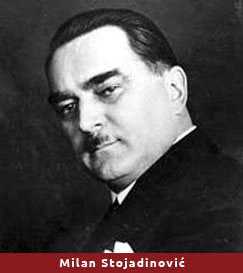 At the very
beginning dictatorship was seen
differently. In his memoires Ni rat
ni pakt /Neither War nor Pact/ Milan
Stojadinović noted down that it was
“iron gloved” but not bloody. Those
affected most by it – communists –
labeled it “fascist dictatorship”
and “military-fascist regime.” The
Communist Party of Yugoslavia, small
at the time (3,500 members) was
harshly persecuted. From 1929 till
1931 82 political trials of
communists were held before the
Court of the Protection of the
State, and 400 members of KPJ and
its youth branch /SKOJ/ were
condemned to death.24 At the very
beginning dictatorship was seen
differently. In his memoires Ni rat
ni pakt /Neither War nor Pact/ Milan
Stojadinović noted down that it was
“iron gloved” but not bloody. Those
affected most by it – communists –
labeled it “fascist dictatorship”
and “military-fascist regime.” The
Communist Party of Yugoslavia, small
at the time (3,500 members) was
harshly persecuted. From 1929 till
1931 82 political trials of
communists were held before the
Court of the Protection of the
State, and 400 members of KPJ and
its youth branch /SKOJ/ were
condemned to death.24
However, there was
no noticeable resistance to the
dictatorship – at least not at the
surface. Even HSS leader Dr. Vladko
Maček thought at first that
annulment of the St. Vitus Day
Constitution was a major achievement
(“the vest is unbuttoned”25). Not
only the Serbian civilian opposition
did not oppose the act of January 6,
1929 but it silently stepped down
the political stage, frightened and
demoralized, and subjected itself to
the laws banning political parties.
But this was not only out of fear
and opportunism – it was about its
tacit support to King Alexander’s
goals.
True, leaders of
political parties were anathemized.
Svetozar Pribićević was interned,
Dr. Vladko Maček put on trial before
the Court for the Protection of the
State, the same as Dragoljub
Jovanović. Dr. Antun Korošec was
interned. August Košutić and Juraj
Krnjević fled the country. It was
hardly convincible that the
dictatorship would be short-lived
and King Alexander would give up the
policy with such a long history and
long-term objectives.
King Alexander was
aware “that the state that is so
deeply diverse needs new values and
symbols beyond local traditions and
specificities.” To safeguard the
state’s unity and stay faithful to
the pan-Serbian ideal of “the entire
state turned Serbian” he was ready
to formally sacrifice the last
Serbian tokens: the name of the
state and its symbols. And this was
where historian Jože Pirjevec saw
through his plan for turning Serbian
the entire state. “According to the
street politics the power should
remain in Serbs’ hands because
Croats and Slovenians, former
Austro-Hungarian subjects, were not
to be trusted and appointed to high
offices.”26
Under the pressure
from his traditional ally, France,
King Alexander decided to provide
the country with a constitutional
form: on September 2, 1931 he
proclaimed the second highest act of
the state of Yugoslavia called
Imposed Constitution /Oktroisani
ustav/. “With trust in Lord and
prosperous future of the Kingdom of
Yugoslavia I am proclaiming the
Constitution of the Kingdom of
Yugoslavia.”27 In his Address
(December 7, 1931) King Alexander
said that the major outcome of the
act of January 6 was, “As a homeland
Yugoslavia is dear to the hearts of
Serbs, Croats and Slovenians alike,
and we are on the right course
towards constant nation-building.”28
And yet, the reality was a different
story.
The Kingdom was
still largely unstable. Prime
ministers were being appointed from
the ranks of politicians who had
supported the regime of January 6.
From April 1931 till December 1934 a
cabinet of Vojislav Marinković, two
cabinets of Milan Srškić and three
of Nikola Uzunović came in a row.
But apart from these changes in
personnel – and notwithstanding the
King’s absolute power and permanent
violence it implied – the regime
needed to ensure for itself more
solid and wider bedrock. And it
found it in a new political
formation named Yugoslav Radical
Peasant Democracy (JRSD). The state
backed it up from “top to bottom.”
It was a precursor of Yugoslav
National Party (JNS) and Yugoslav
Radical Community (JRZ). JNS was
after “overcoming regional borders,
spreading the influence throughout
Yugoslavia and fighting for the
concept of integral Yugoslavianism.”29
And as such it sailed under favor of
King Alexander till his death.
And yet, the
Imposed Constitution was at the same
time seen as a sign of “easing up.”
For the first time after January 6,
1929 representatives of Peasant
Democratic Coalition held a meeting
in Zagreb (November 1932). The
meeting resulted in a resolution
known as “Punktacije” /Basic
Provisions/ or “Zagreb Punktacije”.30
The resolution condemned “Serbian
hegemony” as destructive to the
state. It found an echo throughout
the country: similar documents
started emerging from various sides.
Criticism of the
regime and denial of centralism and
national Unitarianism were important
bearing in mind the growing
separatist tendencies at the time.
As a backlash to the dictatorship of
January 6 separatism increased in
Croatia, Macedonia and Montenegro,
whereas irredentism was more and
more advocated in Kosovo and
Macedonia.
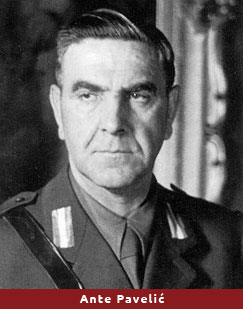 Shortly after
dictatorship was proclaimed Ante
Pavelić, lawyer and MP of Croatian
Party of Rights, fled to Austria. He
was a follower of Croatia’s
political current lawyer Josip Frank
launched in the late 19th century
and took the helm of the party in
1896. Unlike followers of Stjepan
Radić, practically the leader of
those Croats who stood for
federalism and confederalism,
Frank’s supporters were calling for
an independent Croatian state. They
refused any cooperation whatsoever
with Serbs and were backed up by
Hungary and Italy.31 Shortly after
dictatorship was proclaimed Ante
Pavelić, lawyer and MP of Croatian
Party of Rights, fled to Austria. He
was a follower of Croatia’s
political current lawyer Josip Frank
launched in the late 19th century
and took the helm of the party in
1896. Unlike followers of Stjepan
Radić, practically the leader of
those Croats who stood for
federalism and confederalism,
Frank’s supporters were calling for
an independent Croatian state. They
refused any cooperation whatsoever
with Serbs and were backed up by
Hungary and Italy.31
From Austria Ante
Pavelić went to Hungary and then,
via Romania, to Bulgaria. He was
given a ceremonial welcome in Sophia
where he met with Ivan Vaučo
Mihajlov, the leader of VMRO
Bulgarian wing. The two agreed on
joint actions. Pavelić then traveled
to Italy where he began working on
the Ustashi movement. He was
developing the movement’s political
postulates and, at the same time,
planning acts of terrorism,
assassinations and political
murders. He published (1932) the
Principles of the Ustashi
Revolutionary Movement.32
King Alexander
himself became Ustashis’ target. In
1933 in Zagreb he had gone to
celebrate his birthday anniversary
and amend relations with Croats he
was a prey to an assassination
attempt planned by Ante Pavelić.
Gunman Petar Oreb was put on trial
and shot.
Was King
Alexander, having refused to find a
common ground with anti-centralists
and federalists, actually fueling
separatism? Historians disagree
here: some take he was aware that
his policy had suffered defeat and
other that he had pursued it till
the end. The changed balance of
power in Europe resulting from
Hitler’s electoral triumph (January
30, 1933) forced him to strengthen
the Balkan Alliance with reliance of
the original Entente Alliance. At
the same time, while big powers
clashed, he had to test Serbia’s
relationship with its “old” allies.
And so, in early October 1934 he
went to France. On October 9 he was
gunned down in Marseille, his
assassination planned jointly by
Ustashi and VMRO supporters. He was
shot dead: it is nothing but a myth
that he entrusted his entourage with
the safeguard of Yugoslavia. Some
historians argue that his last
“entourage” was actually an
“unseemly tour” of his dead body
from Split to Belgrade,33 while others
labeled the last gathering around
him – a manifestation of people’s
grief.34 However, the will he penned
on January 5, 1934 in Bled testifies
that King Alexander had been afraid
for his life. In the case he left no
successor, as provided under the
constitution, he appointed “triple”
regency: His Royal Highness Prince
Paul Karađorđević, Senator Dr.
Radenko Stanković and Minister of
Education Dr. L. Perović.35
King Alexander’s
assassination put an end to
absolutism as the main pillar of
state centralism and national
Unitarianism; but to the
dictatorship of January 6. First
three cabinets the Regency formed
(the one of Bogoljub Jevtić and two
of Milan Stojadinović) continued the
policy against the settlement of the
“Croat question.” To avoid “the
Slovakian scenario” in Croatia
Prince Paul appointed Dragiša
Cvetković the Prime Minister;
Cvetković had been an unknown
Radical from Niš and member of
Stojadinović’s cabinet. The mission
of this cabinet was to bring about
an agreement between Serbs and
Croats. After brief negotiations the
agreement was signed (August 26,
1939) and further verified by the
governmental decree on Banovina of
Croatia. The state was thus
initially rearranged but federalism
did not have its day. Neither side
was happy with the agreement.
The moment of
truth came at the onset of WWII.
During the ten-year history of the
Imposed Constitution – with King
Alexander claiming the Kingdom of
Yugoslavia was a dear homeland of
Serbs, Croats and Slovenians alike,
notwithstanding the dictatorial
stranglehold – centralism and
national Unitarianism were
dissolving along with the state
based on them; and, as it turned out
in the last act, not a single nation
saw Yugoslavia as its state; no
nation was eager to defend it. The
military catastrophe in 1941 pulled
the plug on the brief, contradictory
and dramatic history of the Kingdom
of Yugoslavia.
|